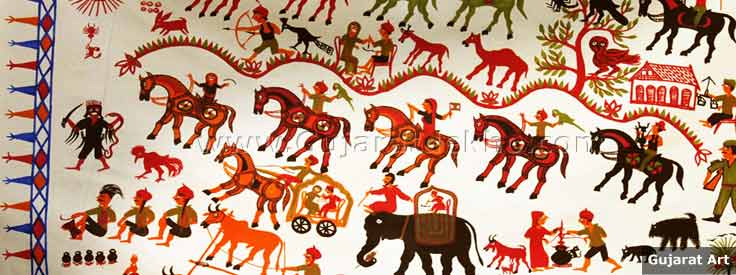Home
Gujarat Art
Gujarat Art
Gujarat is one of the jewels of India. Gujarat Art can be seen in its culture. Paintings in Gujarat mostly portray religious themes and shows stories from the Puranas, and the epics, the Ramayana and the Mahabharata. Tales from the life of Krishna and local folklore have found their way into various miniature art, glass paintings as well as tribal art forms in the state.
Art in Gujarat
Modern and Contemporary Art Movement in Baroda
Modern Indian art began to acquire its clear cut personality in the 1950s under the impact of the Bombay Progressive Artists Group spearheaded by M F Husain, F N Souza and S H Raza. Art became more individualistic, experimental and interesting. In 1957, the dynamic 'Baroda Group of Artists' formed under the guidance of Narayan Shridhar Bendre. The group included prominent artists such as Bhupen Khakkar, Gulam Mohammed Sheikh and many more. The group's exhibitions received attention in both India and the West. The Faculty hosts a biannual Fine Arts Fair in January to encourage students to produce toys, illustrated books, masks and puppets for sale. Check out the list of Gujarat Art such as various Paintings in Gujarat.
Miniature Painting Gujarat
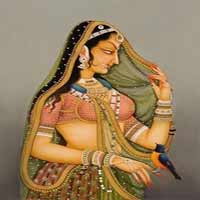 The tradition of miniature painting Gujarat came into existence in eastern India during 8th century, and became popular in the west and Gujarat, in the mid of 10th century. Painted onto palm leaves and tree bark, these examples originally had an ornamental purpose, but soon became visual complement to religious sacred writings. In the beginning, the Gujarat Art of manuscript example was limited to the representation of gods and goddesses. These were taken directly from stone carvings, with idols mostly drawn in three-quarter profile and gods in frontal position as seen in carvings at the Sun Temple in Modhera and Rani Vav in Patan. The faces of gods are characterized by a pointed nose and chin and the further eye protruding beyond the cheek line of the face in profile. The position of the eye is the main characteristic of Gujarat's miniature paintings, which were also used to explain Shvetambar Jain and Vaishnav texts and manuscripts. The Lalbhai Dalpathbhai institute of Indology in Ahmedabad houses about 76,000 handwritten Jain manuscripts with 500 illustrated versions, miniature paintings, cloth paintings, painted scrolls and decorative art. The Miniature Painting Gujarat is a well-known Art in Gujarat.
The tradition of miniature painting Gujarat came into existence in eastern India during 8th century, and became popular in the west and Gujarat, in the mid of 10th century. Painted onto palm leaves and tree bark, these examples originally had an ornamental purpose, but soon became visual complement to religious sacred writings. In the beginning, the Gujarat Art of manuscript example was limited to the representation of gods and goddesses. These were taken directly from stone carvings, with idols mostly drawn in three-quarter profile and gods in frontal position as seen in carvings at the Sun Temple in Modhera and Rani Vav in Patan. The faces of gods are characterized by a pointed nose and chin and the further eye protruding beyond the cheek line of the face in profile. The position of the eye is the main characteristic of Gujarat's miniature paintings, which were also used to explain Shvetambar Jain and Vaishnav texts and manuscripts. The Lalbhai Dalpathbhai institute of Indology in Ahmedabad houses about 76,000 handwritten Jain manuscripts with 500 illustrated versions, miniature paintings, cloth paintings, painted scrolls and decorative art. The Miniature Painting Gujarat is a well-known Art in Gujarat.
Glass Painting Gujarat
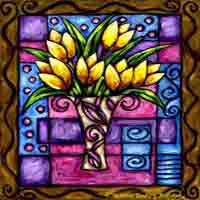 Gujarat is also famous for its glass paintings. The glass painting is practiced in Gujarat dating from the late 18th century. The Reverse glass painting came into existence in Europe and was introduced to China during the Qing Dynasty's reign. The trade links between the East India Company and China brought this Glass Painting art form to India. The Chinese artisans were also humiliated by the rulers of Mysore, Satara and Kachchh. Gradually, local artisans started experimenting with glass imported from Belgium and Britain, using bright colors, gold leaves and semi-precious stones. The themes were based on stories of Radha and Krishna, other mythologies as well as the lives of local aristocrats. The Glass Painting Gujarat is among the eye-catching Art in Gujarat.
Gujarat is also famous for its glass paintings. The glass painting is practiced in Gujarat dating from the late 18th century. The Reverse glass painting came into existence in Europe and was introduced to China during the Qing Dynasty's reign. The trade links between the East India Company and China brought this Glass Painting art form to India. The Chinese artisans were also humiliated by the rulers of Mysore, Satara and Kachchh. Gradually, local artisans started experimenting with glass imported from Belgium and Britain, using bright colors, gold leaves and semi-precious stones. The themes were based on stories of Radha and Krishna, other mythologies as well as the lives of local aristocrats. The Glass Painting Gujarat is among the eye-catching Art in Gujarat.
Kamangari Wall Painting Gujarat
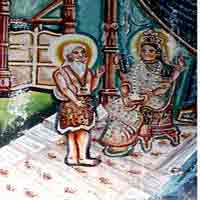 Kamangari wall painting is a Gujarat art form particular to Kachchh. The rich people would task to artists to paint the walls of their houses, places of work and worship. The Kamangari wall paintings were done on a wet plastered wall to make them last longer. The Brushes used for Kamangari wall paintings are made from the bark of palm trees and colors extracted from leaves, pebbles and clay mixed with gypsum were used to paint scenes from Indian epics and the stories of local people. Some Kamangari wall paintings even featured cricket matches, trains and planes, which did not exist in Kachchh until a century ago, themes that may have been introduced by traders who had travelled afar. The arrival of the British in Kachchh provided more themes to the Kamangari artists who started portraying uniformed policemen and band parties in their murals. The first British political agent of this region, Captain McMurdo, hired an artist to paint the walls of his house in Anjar with the scenes from the Ramayana. It is one of the few places where this Kamangari wall painting art is still preserved. This Kutch Museum and Aaina Mahal in Bhuj have eye-catching collection of Kamangari Wall Painting Gujarat. The Glass Painting Gujarat is among the eye-catching Art in Gujarat. The Kamangari Wall Painting Gujarat is among the famous Art of Gujarat.
Kamangari wall painting is a Gujarat art form particular to Kachchh. The rich people would task to artists to paint the walls of their houses, places of work and worship. The Kamangari wall paintings were done on a wet plastered wall to make them last longer. The Brushes used for Kamangari wall paintings are made from the bark of palm trees and colors extracted from leaves, pebbles and clay mixed with gypsum were used to paint scenes from Indian epics and the stories of local people. Some Kamangari wall paintings even featured cricket matches, trains and planes, which did not exist in Kachchh until a century ago, themes that may have been introduced by traders who had travelled afar. The arrival of the British in Kachchh provided more themes to the Kamangari artists who started portraying uniformed policemen and band parties in their murals. The first British political agent of this region, Captain McMurdo, hired an artist to paint the walls of his house in Anjar with the scenes from the Ramayana. It is one of the few places where this Kamangari wall painting art is still preserved. This Kutch Museum and Aaina Mahal in Bhuj have eye-catching collection of Kamangari Wall Painting Gujarat. The Glass Painting Gujarat is among the eye-catching Art in Gujarat. The Kamangari Wall Painting Gujarat is among the famous Art of Gujarat.
Raja Ravi Varma Painting Gujarat
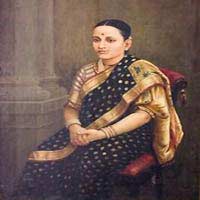 During British rule, Indian artists found sponsors in Indian kings such as Maharaja Sayajirao Gaekwad III of Baroda, who invited Raja Ravi Varma, who was among the India's greatest artists during British rule, to paint at his court. Ravi Varma, from the princely state of Travancore, first came to Baroda in 1881 to paint the religious event portrait of Sayajirao III. Later, the ruler ordered fourteen mythological paintings for the Laxmi Vilas Palace in Baroda. Ravi Varma's paintings displayed at the Baroda Museum and the Palace are intricate, well-executed and eye-catching. His representation of mythological characters has become a part of the Indian imagination of the epics and his paintings have inspired not just calendar art but also Indian cinema and theatre. The Raja Ravi Varma Painting Gujarat is among the fascinating Art of Gujarat.
During British rule, Indian artists found sponsors in Indian kings such as Maharaja Sayajirao Gaekwad III of Baroda, who invited Raja Ravi Varma, who was among the India's greatest artists during British rule, to paint at his court. Ravi Varma, from the princely state of Travancore, first came to Baroda in 1881 to paint the religious event portrait of Sayajirao III. Later, the ruler ordered fourteen mythological paintings for the Laxmi Vilas Palace in Baroda. Ravi Varma's paintings displayed at the Baroda Museum and the Palace are intricate, well-executed and eye-catching. His representation of mythological characters has become a part of the Indian imagination of the epics and his paintings have inspired not just calendar art but also Indian cinema and theatre. The Raja Ravi Varma Painting Gujarat is among the fascinating Art of Gujarat.
Tribal Art Gujarat
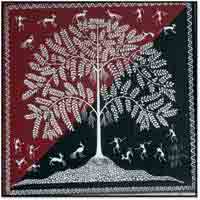 The Tribal art Gujarat shows the concept of man as part of a large universe. Unlike most Indian painting traditions which use number of colors and fine details, these Tribal Art Gujarat portray everyday village lifetsyle using basic bold strokes and a simple color palette. The Gujarat's most famous tribal art forms are Warli Painting, Mata Ni Pachedi and Pithora. The Tribal Art Gujarat is among the interesting Art of Gujarat.
The Tribal art Gujarat shows the concept of man as part of a large universe. Unlike most Indian painting traditions which use number of colors and fine details, these Tribal Art Gujarat portray everyday village lifetsyle using basic bold strokes and a simple color palette. The Gujarat's most famous tribal art forms are Warli Painting, Mata Ni Pachedi and Pithora. The Tribal Art Gujarat is among the interesting Art of Gujarat.
Mata ni Pachedi
Mata ni Pachedi is a 200 year old textile craft form used by the nomadic Vaghari community to create temporary holy places for the Mother Goddess. The traditional maroon, sourced from alizarin, is related with the color of Mother Earth and it is said to possess healing powers. Black, extracted from oxidized metal, repulses malicious spirits and intensifies spiritual energy. White is related with purity and contact with ancestral spirits. Such paintings can be seen at the Lalbhai Dalpatbhai Museum, Calico Museum in Ahmedabad and Baroda Museum and Art Gallery in Vadodara. This Gujarat Art is very fascinating.
Pithora
Pithora, practiced by the Nayak, Rathwa and Bhil communities around Chhota Udepur, is a ritualistic wall painting to mark favourable occasions such as marriages, childbirth and festivals. The walls of houses are first plastered with cow dung and mud by unmarried girls, and then coated with chalk powder. Colors are made by mixing paints with milk and liquor developed from the favorable Mahuda tree. The painting is an offering to the Baba to bring peace and wealth, succcess. This Gujarat Art is very interesting.
Warli
Warli Painting belongs to the Warli tribe based in south Gujarat and northwestern Maharashtra. The murals use a very basic graphic vocabulary that is a circle, a triangle and a square. The circle portray the sun and the moon, the triangle portray the mountains and pointed trees. The central motive in each Warli painting is the square, which portray a sacred place or piece of land. First the mud walls are coated with a cow-dung paste and then gheru (red soil). Wooden sticks are used for brushes to paint scenes of hunting, dancing and cultivation, geometrical patterns of trees, birds and animals. Warlis decorate their houses with these images in honor of various occasions such as birthday or weddings. This Gujarat Art is very popular among Gujarat People.
